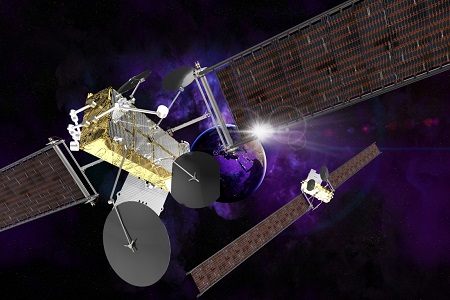Software-defined technology will bring more flexibility in space, allowing people on the ground to adapt to market changes and create connectivity on-demand, where and when needed, says Carmel Ortiz.

Carmel Ortiz is Vice President, Systems Innovation at Intelsat.
A few years back, as we set out to reassess our strategy based on our customers growing connectivity needs, we looked at how to optimise an already powerful network. We had a clear vision of what we wanted to achieve: we needed to be able to deliver the exact bandwidth our customers would need, when and where they would need it. We also needed to ease the provisioning of new connectivity services and be able to respond to traffic spikes in a matter of seconds. We needed to enable telecom operators to quickly and efficiently extend the reach of their network, while allowing airlines and cruise ships to benefit from a seamless, always-on experience. For this, we needed to design a truly global and unified 5G network to answer the call for high-speed, reliable, dynamic coverage on a global scale.
While our network of traditional and high-throughput satellites already responded to our customers connectivity needs, we looked at how we could evolve the design of our combined satellite and ground networks to accelerate performance and flexibility. Following a thorough assessment of various technologies, we determined that the advanced software-defined satellite technology envisioned was critical to enabling us to respond to these growing requirements and would be the catalyst for our growth. Today, we have more than ten software-defined satellites planned, including four already in production.
Technology investments and innovations over the past few years have coalesced to maximise the effective and efficient use of satellite resources. Fully reconfigurable while in orbit, software-defined satellites allow bandwidth to be dynamically adapted and flexibly reconfigured to concentrate capacity where demand is highest. Unlike traditional and high-throughput satellites, we no longer have to decide in advance where to provide service and capacity. And with faster build and deployment times, software-defined satellites eliminate network bottlenecks.
Realising the benefits requires an equally innovative and advanced ground network space and ground components working seamlessly to detect changes in customer demand and dynamically reconfigure capacity and service coverage. The future is software-defined everything! Satellite beam size, power and bandwidth change in response to signals from terminals, hubs and our advanced resource management system, providing continuous connectivity over land, sea and air, resulting in uninterrupted, high-quality service for aircraft and ships.
The combination of ground network innovations with these satellites enables greater agility, flexibility and automated network orchestration. Software-defined technology will bring more flexibility in space so that people on the ground can adapt to market changes and create connectivity on demand, where and when needed.
While all software-defined satellites announced so far are geostationary (GEO), what ultimately matters for end users is not the orbit or the frequency band, it is the networks performance, availability and value proposition. We believe strongly that GEO has the best economics from a cost-per-bit and total cost of ownership perspective and will always be well-positioned to address these key requirements.
While all software-defined satellites announced so far are geostationary, what ultimately matters for end users is not the orbit or the frequency band, it is the networks performance, availability and value proposition – Carmel Ortiz, VP, Systems Innovation, Intelsat.
GEO satellites are unmatched in their ability to focus coverage over densely populated areas; even more so with software-defined GEO satellites, which means no wasted capacity over unpopulated areas. Having said that, non-geostationary (NGSO) constellations have compelling benefits in terms of latency, terminal look angle and ubiquity. We fully believe that ultimately the best networks will be multi-orbit, combining the benefits of GEO and NGSO in a complementary way.
Unleashing 5G and new apps
5G will open up a new era for communications, bringing more homes and enterprises online, increasing throughput and efficiency, enabling more powerful applications and opening new business opportunities. The technology will make the fourth industrial revolution a reality, with 5G-powered smart cities, smart homes and smart agriculture transforming the way we live and work.
To make 5G successful, all stakeholders must put in place the building blocks to maximise the opportunity that the technology can bring. Our industry is a key stakeholder, and we can bring satellite communications into the telecommunications mainstream by adopting 5G standards in our networks. This is an opportunity to seamlessly integrate with terrestrial infrastructure, to allow our customers to deploy applications and services globally without the custom adaptations often required for satellite deployments. We can expand the ecosystem of suppliers, driving down cost and increasing flexibility. This will enable us to adapt and respond to users growing connectivity requirements as they evolve in real-time.
5G will enable many ground-breaking applications, with software-defined satellites playing a key role in realising the technologys full potential, complementing the capabilities of terrestrial networks and helping to bring network connectivity to places they cant reach. Enterprises will be able to securely access public and private cloud-based applications from virtually anywhere in the world. With satellite beams capable of following aircraft individually anywhere in the world, airlines will always get the capacity they need, enabling them to develop new business models based on the provision of reliable and robust inflight Wi-Fi to passengers. Defence customers will benefit from capacity which can be dynamically allocated, tracking aircraft, troops or ships to deploy resources precisely where they are needed.
The successful deployment of 5G networks will require engagement with the broader telecom ecosystem and embracing the same standards and partnerships. This is fundamental. We believe that 3GPPs 5G specification, known as Release 17, should bring all the specifications necessary for this integration, and with it the ability to drive new business models.
Empowering underserved areas
The roll-out of 5G technology across Africa is still in its early stages, but analysts expect significant volumes of 5G subscriptions by 2022. Satellite communications networks built on 5G standards can help accelerate 5G deployments in places where terrestrial infrastructure is not available. Adoption of standards used by the telecom industry, combined with software-defined satellites, will help make 5G a reality.
Carmel Ortiz is Vice President, Systems Innovation at Intelsat.













































































